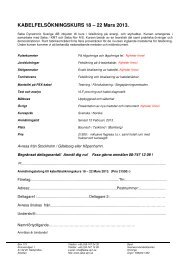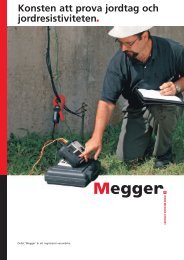A practical guide to earth resistance testing - Weschler Instruments
A practical guide to earth resistance testing - Weschler Instruments
A practical guide to earth resistance testing - Weschler Instruments
You also want an ePaper? Increase the reach of your titles
YUMPU automatically turns print PDFs into web optimized ePapers that Google loves.
APPENDIX IX<br />
Ground Testing Methods Chart<br />
*Method<br />
Best Applications<br />
Advantages<br />
Limitations<br />
1. Fall of Potential<br />
2. Simplified Fall<br />
of Potential<br />
3. 61.8% Rule<br />
4. Slope<br />
5. Intersecting<br />
Curves<br />
6. Dead Earth<br />
(Two Point)<br />
7. Star Delta<br />
8. Four Potential<br />
9. Clamp-On<br />
Small electrode systems (1 or 2 rods/plates);<br />
complex systems if full <strong>resistance</strong> curve is plotted<br />
Small and medium electrode systems<br />
Small and medium electrode systems<br />
Large ground systems like substations<br />
Large ground systems like substations<br />
Not recommended<br />
Ground systems located in congested urban areas and/or rocky<br />
terrain where probe positioning is difficult<br />
Medium <strong>to</strong> large ground systems<br />
Simple ground system with existing return path<br />
through multiple grounds<br />
Extremely reliable; conforms <strong>to</strong> IEEE 81;<br />
opera<strong>to</strong>r has complete control of test set-up<br />
Easier <strong>to</strong> carry out than full Fall of Potential;<br />
much faster<br />
Simplest <strong>to</strong> carry out; minimal calculation;<br />
fewest number of test probe moves<br />
Knowledge of electrical center not necessary;<br />
long distances <strong>to</strong> test probes not necessary<br />
Knowledge of electrical center not necessary;<br />
long distances <strong>to</strong> test probes not necessary<br />
Quick and simple <strong>to</strong> perform<br />
Long distances for test probe positioning<br />
not necessary<br />
Knowledge of electrical center not necessary<br />
Quick, easy; includes bonding and overall<br />
connection <strong>resistance</strong><br />
Requires long distances (and long test leads)<br />
<strong>to</strong> the test probes on medium and large<br />
systems; time consuming and labor intensive<br />
Ineffective if the electrical center is<br />
unknown; less accurate than full Fall of<br />
Potential as less measurements are being<br />
made<br />
Assumes perfect conditions; ineffective if<br />
electrical center is unknown; soil must be<br />
homogeneous; less accurate<br />
Susceptible <strong>to</strong> non-homogeneous soil; less<br />
accurate; requires math<br />
Numerous calculations and drawing of<br />
curves<br />
Problems of possible <strong>resistance</strong> overlap;<br />
non-metallic (high <strong>resistance</strong>) return<br />
Resistance areas should not overlap; a<br />
number of calculations required<br />
Long distances <strong>to</strong> test probes is still required;<br />
a number of calculations required<br />
Effective only in situations with multiple<br />
grounds in parallel; susceptible <strong>to</strong> noise; no<br />
basis in standards; no built-in proof<br />
*The Attached Rod Technique (ART) is based on Fall of Potential<br />
72 1-866-254-0962 www.megger.com Getting Down <strong>to</strong> Earth 73




